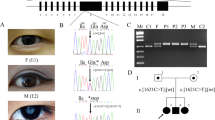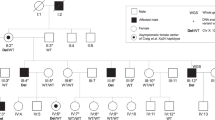Abstract
Cerulean cataract is an autosomal dominant, early onset, progressive cataract characterized by blue or white opacifications in the nucleus and cortex of the lens. A large four–generation pedigree in which cerulean cataract segregates was studied for linkage analysis. A genome wide search was undertaken after the plausible candidate genes were excluded and the cerulean cataract phenotype was mapped to chromosome 17q24. The three markers closest to the disease gene are D17S802 (Z(θ)=9.46 at (θ)=0.085), D17S836 (Z(θ)=5.26 at (θ)=0.031) and AFMa238yb5 (Z(θ)=7.11 at (θ)=0.032). Multipoint linkage analyses yielded a maximum lod score of Z(θ)=13.71, placing the cerulean cataract gene between D17S802 and D17S836 at (θ)=0.048 and (θ)=0.013, respectively.
This is a preview of subscription content, access via your institution
Access options
Subscribe to this journal
Receive 12 print issues and online access
$209.00 per year
only $17.42 per issue
Buy this article
- Purchase on Springer Link
- Instant access to full article PDF
Prices may be subject to local taxes which are calculated during checkout
Similar content being viewed by others
References
Reese, P.D., Truck-Muller, C.M. & Maumenee, I.H. Autosomal dominant congenital cataract associated with chromosomal translocation [t (3;4) (p26 2;p15)]. Arch. Ophthalmol. 105, 1382–1384 (1987).
Renwick, J.H. & Lawler, S.D. Probable linkage between a congenital cataract locus and the Duffy blood group locus. Ann. hum. Genet. 27, 67–84 (1963).
Lubsen, N.H., Renwick, J.H., Tsui, L.-C., Breitman, M.L. & Schoenmakere, J.G.G. A locus for a human hereditary cataract is closely linked to the γ-crystallin gene family. Proc. natn. Acad. Sci. U.S.A. 84, 489–492 (1987).
Eiberg, H., Marner, E., Rosenberg, T. & Mohr, J. Marner?s cataract assigned to chromosome 16: linkage to haptoglobln. Clin. Genet. 34, 272–275 (1988).
Maumenee, I.H. Classification of hereditary cataracts in childern by linkage analysis Opthalmology 86, 1554–1558 (1979).
Brakenhoff, R.H., Henskens, H.A.M., vanRossum, M.W.P.C., Lubsen, N.H. & Schoenmakers, J.G.G. Activation of the γE-crystallin pseudogene in the human hereditary Coppock-like cataract. Hum. molec. Genet. 3, 279–283 (1994).
Vogt, A. Die spezifitat ander borener und erworbener starformer fur die einzelnen linsezonene. Albrecht Von Graefes Arch. Kiln. Exp. Ophthalmol. 108, 219–228 (1922).
Kivlin, J., Lovrien, E., George, C., Cannon, L. & Maumenee, I. Linkage between Cerulean cataract and PGP. Cytogenet. Cell Genet. 40, 669 (1985).
Bodker, F.S., Lowery, M.A., Mitchell, T.N., Lovrien, E. & Maumenee, I. Microphthalmos in the presumed homozygous offspring of a first cousin marriage and linkage analysis. Am. J. med. Genet. 37, 54–59 (1990).
Gorin, M.B., Yancey, S.B., Cline, J.-P., Revel, J.-P. & Horowitz, J. The major intrinsic protein (MIP) of the bovine lens fibre cell membrane: characterization and structure based on cDNA cloning. Cell 39, 49–59 (1984).
Broekhuyse, R.M., Kuhlman, E.D. & Stols, A.L. Lens membrane II.Isolation and characterization of the main intrinsic polypeptide (MIP) of bovine lens fiber membranes. Exp. Eye Res. 23, 365–371 (1976).
Yancey, S.B., Koh, K., Chung, J. & Rvel, J.-P. Expression of the gene for major intrinsic polypeptide (MIP): Separate spatial distribution of MIP and β-crystallin gene transcripts in rat lens development. J. Cell Biol. 106, 705–714 (1988).
Beutler, E. et al. Galactokinase deficiency as a cause of cataracts. New Engl. J. Med. 288, 1203–1206 (1973).
Skalka, H.W. & Prchal, J.T. Presenile cataract formation and decreased activity of galactosemic enzymes. Arch. Ophthal. 98, 269–273 (1980).
Stambolian, D., Scarpino-Myers, V., Eagle, R.C., Hodes, B. & Harris, H. Cataracts in patients heterozygous for galactokinase deficiency. Invest. Ophthalmol. Vis. Sci. 27, 429–433 (1986).
Elsevier, S.M. et al. Assignment of the gene for galactokinase to human chromosome 17 and its regional localisation to band 17q21–22. Nature 251, 633–636 (1974).
Tomarev, S.I. & Zinovieva, R.D. Squid major lens polypeptides are homologous to glutothione S-transferase subunits. Nature 336, 86–88 (1988).
Wistow, G. & Piatigorsky, J. Recruitment of enzymes as lens structural proteins. Science 236, 1554–1555 (1987).
Ott, J. Computer-simulation methods In human linkage analysis. Proc. natn. Acad. Sci. U.S.A. 86, 4175–4177 (1989).
Lathrop, G.M., Lalouel, J.M., Julien, C. & Ott, J. Strategies for multilocus linkage analysis in humans. Proc. natn. Acad. Sci. U.S.A. 81, 3443–3446 (1984).
Schaffer, A.A., Gupta, S.K., Shriram, K. & Cottingham, R.W. Avoiding recomputation in linkage analysis. Hum. Hered. 44, 225–237 (1994).
Gyapay, G. et al. The 1993–94 Généthon human genetic linkage map. Nature Genet. 7, 246–339 (1994).
Author information
Authors and Affiliations
Rights and permissions
About this article
Cite this article
Armitage, M., Kivlin, J. & Ferrell, R. A progressive early onset cataract gene maps to human chromosome 17q24. Nat Genet 9, 37–40 (1995). https://doi.org/10.1038/ng0195-37
Received:
Accepted:
Issue Date:
DOI: https://doi.org/10.1038/ng0195-37
This article is cited by
-
Quantitative investigation of the effect of surgically induced hypoparathyroidism on cataract development
Journal of Bone and Mineral Metabolism (2022)
-
In-vivo anterior segment OCT imaging provides unique insight into cerulean blue-dot opacities and cataracts in Down syndrome
Scientific Reports (2020)
-
Cataract surgery in infants with microphthalmos
Graefe's Archive for Clinical and Experimental Ophthalmology (2015)
-
Differential effect of cataract-associated mutations in MAF on transactivation of MAF target genes
Molecular and Cellular Biochemistry (2014)
-
A novel locus for autosomal dominant congenital cerulean cataract maps to chromosome 12q
European Journal of Human Genetics (2011)



